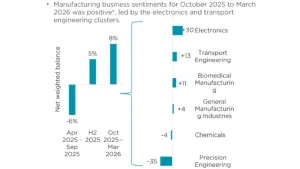
Vietnam manufacturing activity declines in December amidst production growth and new orders decline
Business confidence was at its lowest in 19 months.
The Vietnamese manufacturing sector experienced a slowdown at the end of 2024, with a decline in both production growth and new orders, an S&P Global survey said.
The S&P Global Vietnam Manufacturing Purchasing Managers' Index (PMI) dropped to 49.8 in December from 50.8 in November, signalling a slight deterioration in the overall business climate.
Despite a slight uptick in purchasing activity, companies responded by reducing employment and cutting back on inventory levels. Business confidence fell to its lowest point in 19 months, highlighting concerns about the ongoing economic environment.
Whilst there were increases in output and new orders, these growth rates were minimal and the weakest over the last three months. Some companies reported improvements in demand, whereas others noted a softening in market conditions.
New business remained on the rise, but export orders fell for the second consecutive month and at a notable rate. Global market instability and uncertainty significantly impacted businesses' confidence regarding future production. Sentiment dropped sharply in December, marking the lowest level since May 2023.
The report said that despite these challenges, manufacturers remained cautiously optimistic about future output, aided by expectations of new orders and improved economic conditions.
In response to anticipated increases in output, the purchasing activity saw a resurgence, the most significant increase noted in four months. However, firms were cautious and preferred to keep low inventory levels, resulting in reduced stocks of purchases and finished goods.
For the third straight month, employment in the sector decreased, reflecting the subdued growth in new orders. Although the reduction was modest, it was the sharpest since August, leading to a build-up of backlogs, which extended the sequence of rising outstanding business to seven months. Nonetheless, this increase was minimal and represented the slowest in that span.
Inflationary pressures also intensified in December, with both input costs and output prices rising sharply—factors attributed to material shortages and currency fluctuations. Key materials like oil and metals were noted as substantial contributors to the rising costs. Consequently, companies raised their output prices for the eighth consecutive month, reflecting a faster rate than seen in previous months.
Suppliers faced longer delivery times for the fourth consecutive month, although the delays were modest.















